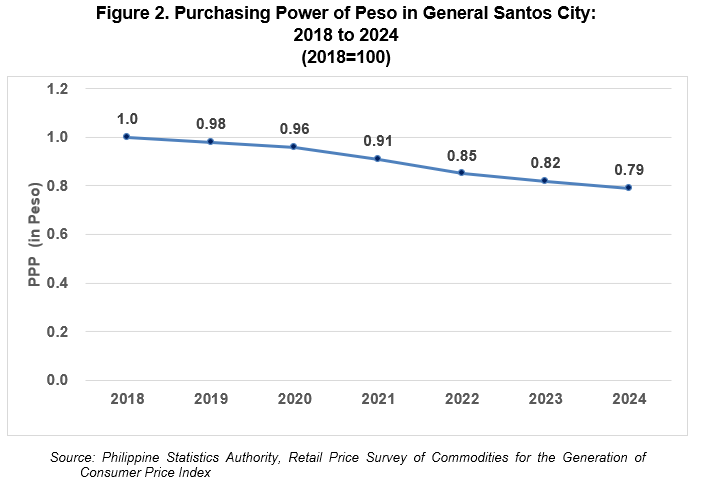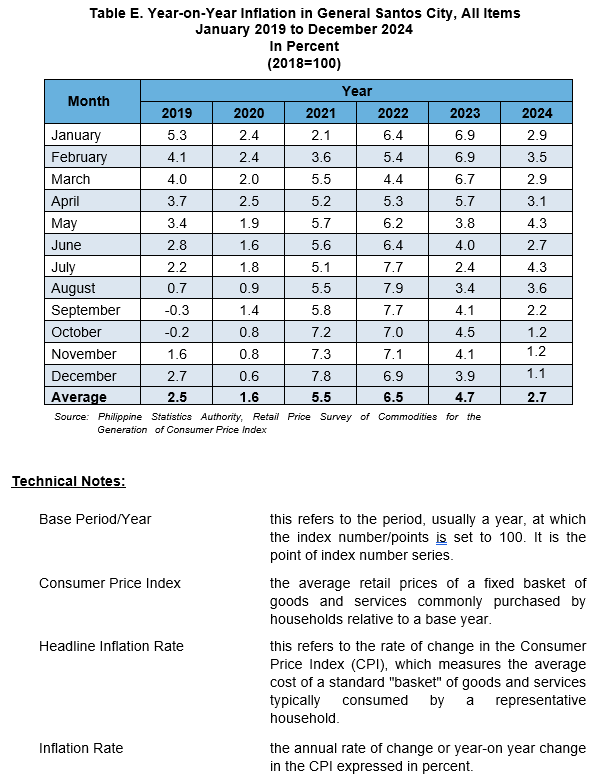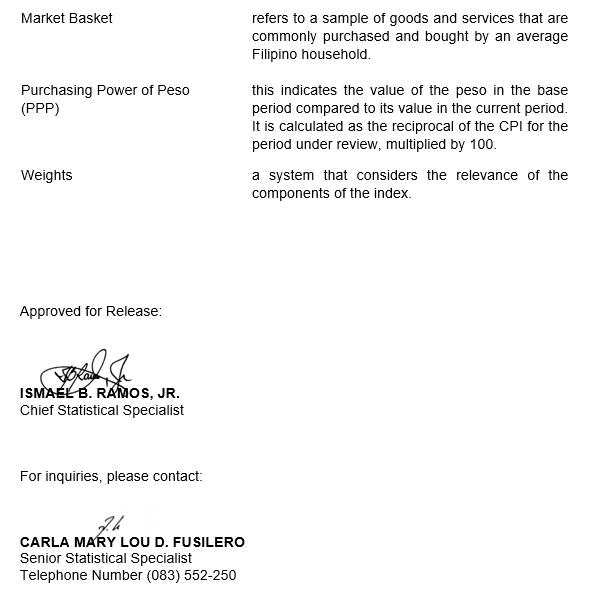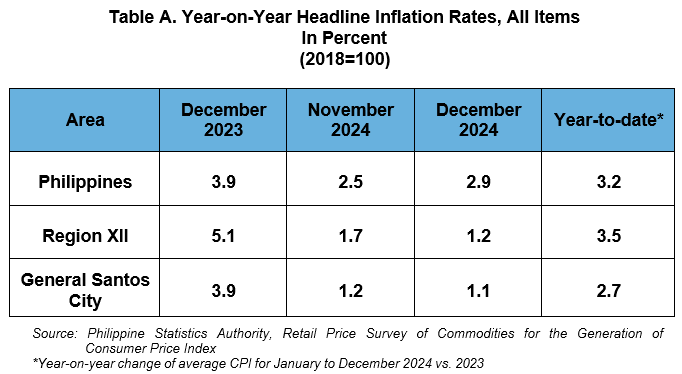
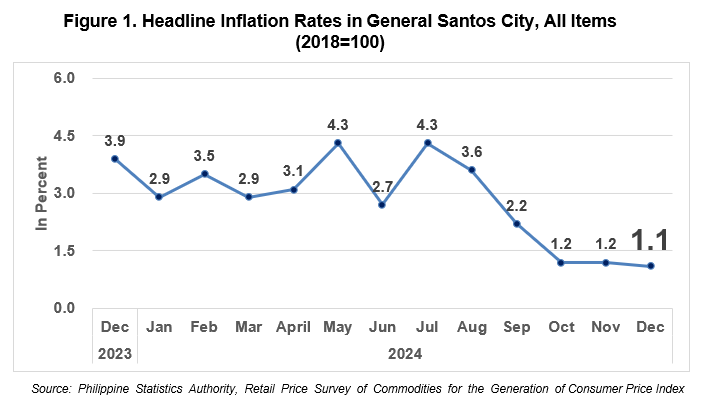
A. General Santos City
1. Overall Inflation
The General Santos City’s headline inflation eased to 1.1 percent in December 2024 from 1.2 percent in November 2024. In December 2023, the inflation rate was higher at 3.9 percent. (Table A and Figure 1)
1.1 Main Drivers to the Downward Trend of the Overall Inflation (refer to Table B)
The downtrend in the city’s inflation rate in December 2024 was mainly driven by the lower annual increment in the index of food and non-alcoholic beverages at 1.5 percent from 2.2 percent inflation in November 2024.
On the contrary, the following commodity groups registered higher inflation rates during the month:
a. Alcoholic beverages and tobacco, 2.4 percent from 2.3 percent;
b. Housing, water, electricity, gas and other fuels, 0.9 percent from 0.8 percent;
c. Furnishings, household equipment and routine household maintenance, 0.3 percent from 0.2 percent; and
d. Transport, -0.5 percent from -2.4 percent.
The indices of the rest of the commodity groups retained their previous month’s inflation rates in December 2024 as follows:
a) Clothing and footwear, at 0.7 percent;
b) Health, at 1.4 percent;
c) Information and communication, at zero inflation;
d) Recreation, sport and culture, at 0.7 percent;
e) Education services, at 8.7 percent;
f) Restaurants and accommodation services, at zero inflation;
g) Financial services, at zero inflation; and
h) Personal care and miscellaneous goods and services, at 1.0 percent.
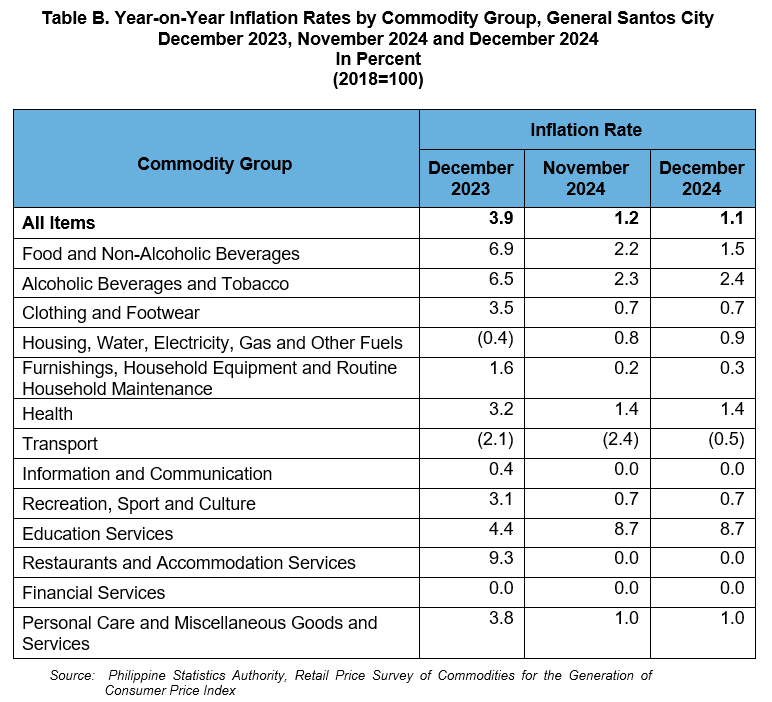
1.2 Main Contributors to the Overall Inflation
The top three commodity groups contributing to the December 2024 overall inflation were the following:
a) Food and non-alcoholic beverages with 53.8 percent share or 0.6 percentage point;
b) Education services with 18.1 percent share or 0.2 percentage point; and
c) Housing, water, electricity, gas and other fuels with 15.7 percent share or 0.2 percentage point.
2. Annual Average Inflation
The city’s annual average inflation rate for 2024 stood at 2.7 percent, which was lower than the 2023 annual average inflation rate of 4.7 percent.
2.1 Main Drivers to the Downward Trend of the 2024 Annual Average Inflation (refer to Table C)
The downtrend in the 2024 annual average inflation at the city level was primarily caused by the lower annual average increase in the index of food and non-alcoholic beverages at 4.7 percent in 2024 from 7.8 percent annual average inflation in 2023. Also, the index of restaurants and accommodation services showed a downtrend at 3.5 percent annual average inflation in 2024 from 7.8 percent in 2023. Also contributed to the lower average inflation of the city was the index of housing, water, electricity, gas and other fuels at 0.9 percent in 2024 from 1.6 percent annual average inflation in 2023.
Moreover, the following indices recorded a downtrend in their annual average inflation in 2024 compared with 2023:
a) Alcoholic beverages and tobacco, with 4.1 percent from 7.9 percent;
b) Clothing and footwear, with 1.8 percent from 4.3 percent;
c) Furnishings, household equipment and routine household maintenance, with 0.7 percent from 2.6 percent;
d) Health, with 1.9 percent from 3.0 percent;
e) Transport, with -1.1 percent from -0.7 percent;
f) Information and communication, with 0.2 percent from 0.7 percent;
g) Recreation, sport, and culture, with 2.0 percent from 4.6 percent; and
h) Personal care and miscellaneous goods and services, with 2.5 percent from 4.3 percent.
In contrast, the index of education services registered a higher annual average inflation at 6.6 percent in 2024 from 4.5 percent in 2023.
The index of financial services maintained their previous year’s annual average inflation rate recorded at zero percent.
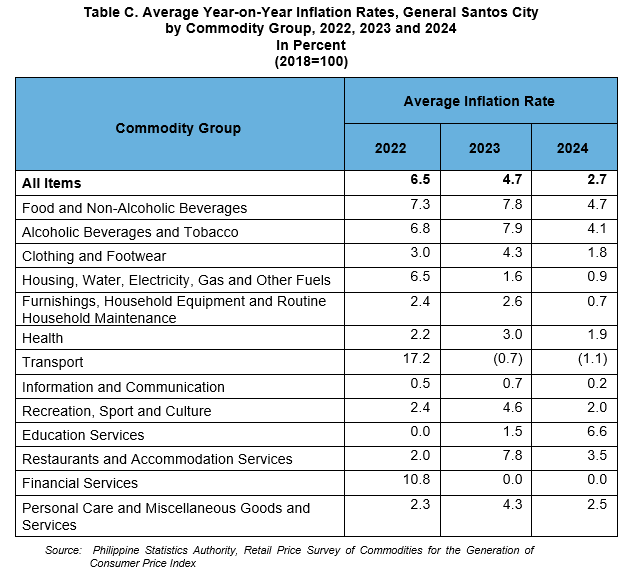
2.2 Main Contributors to the 2024 Annual Average Inflation
The top three commodity groups contributing to the city’s 2024 annual average inflation were the following:
a) Food and non-alcoholic beverages with 67.6 percent share or 1.8 percentage points:
b) Restaurants and accommodation services with 10.8 percent share or 0.3 percentage point; and
c) Housing, water, electricity, gas and other fuels with 6.3 percent share or 0.2 percentage point.
3. Food Inflation
Food inflation in General Santos City decreased to 1.5 percent in December 2024 from 2.2 percent in November 2024. In December 2023, food inflation was higher at 7.1 percent.
3.1 Main Drivers to the Downward Trend of the Food Inflation (refer to Table D)
The deceleration of food inflation in December 2024 was due to lower annual increase in the index of fish and other seafood with 4.8 percent from 7.8 percent in November 2024. Also, the index of rice showed a downward trend at -2.2 percent in December 2024 from -0.8 percent in November 2024. The index of fruits and nuts also contributed to the downtrend at 6.9 percent during the month from 11.1 percent in November 2024.
Moreover, the flour, bread and other bakery products, pasta products, and other cereals contributed lower annual increment at 0.7 percent during the month from 1.0 percent in November 2024.
In contrast, higher annual increments were noted in the indices of the following food groups during the month:
a) Corn, 8.4 percent from 6.1 percent;
b) Meat and other parts of slaughtered land animals, 2.5 percent from 1.4 percent;
c) Milk, other dairy products and eggs, 1.9 percent from 1.2 percent;
d) Oils and fats, 6.5 percent from 3.6 percent;
e) Vegetables, tubers, plantains, cooking bananas and pulses, 0.6 percent from -0.5 percent;
f) Sugar, confectionery and desserts, -4.3 percent from -5.4 percent; and
g) Ready-made food and other food products n.e.c., 5.4 percent from 5.3 percent.
3.2 Main Contributors to the Food Inflation
Food inflation contributed 47.7 percent or 0.5 percentage point to the December 2024 overall inflation. The top three food groups in terms of contribution to the food inflation during the month were the following:
a) Fish and other seafood, with a share of 61.9 percent or 0.9 percentage point;
b) Meat and other parts of slaughtered land animals, with a share of 25.9 percent or 0.4 percentage point; and
c) Fruits and nuts, with a share of 18.8 percent or 0.3 percentage point.
3.3 Annual Average Food Inflation
In 2024, the annual average food inflation rate was observed at 4.9 percent, lower than the recorded annual average food inflation rate of 7.8 percent in 2023.
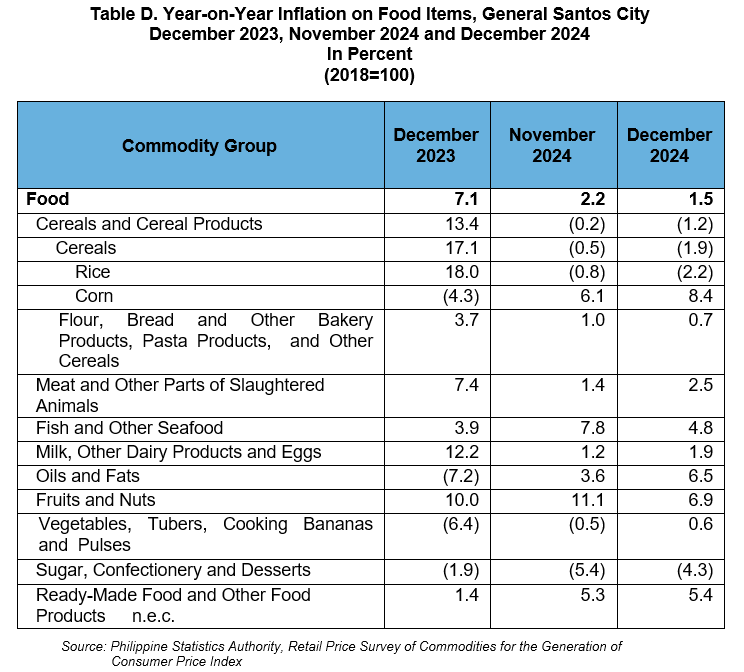

The Purchasing Power of Peso (PPP) in General Santos City decreased to 0.79 in December 2024 from 0.80 in November 2024. This means that a peso in 2018 is only worth 79 centavos in December 2024, or you need PhP 126.0 to purchase the same goods and services that cost PhP 100.00 in 2018.
The PPP is inversely related to inflation rate. Therefore, as the inflation rate decreases, PPP inclines. In General Santos City, PPP has been decreasing on the average of 0.04 annually from 2018 to 2024. By comparison, the PPP in 2024 was 0.79 which implies that the PhP 1.00 in 2018 as the base year, values only PhP 0.79 in 2024. (Figure 2)
